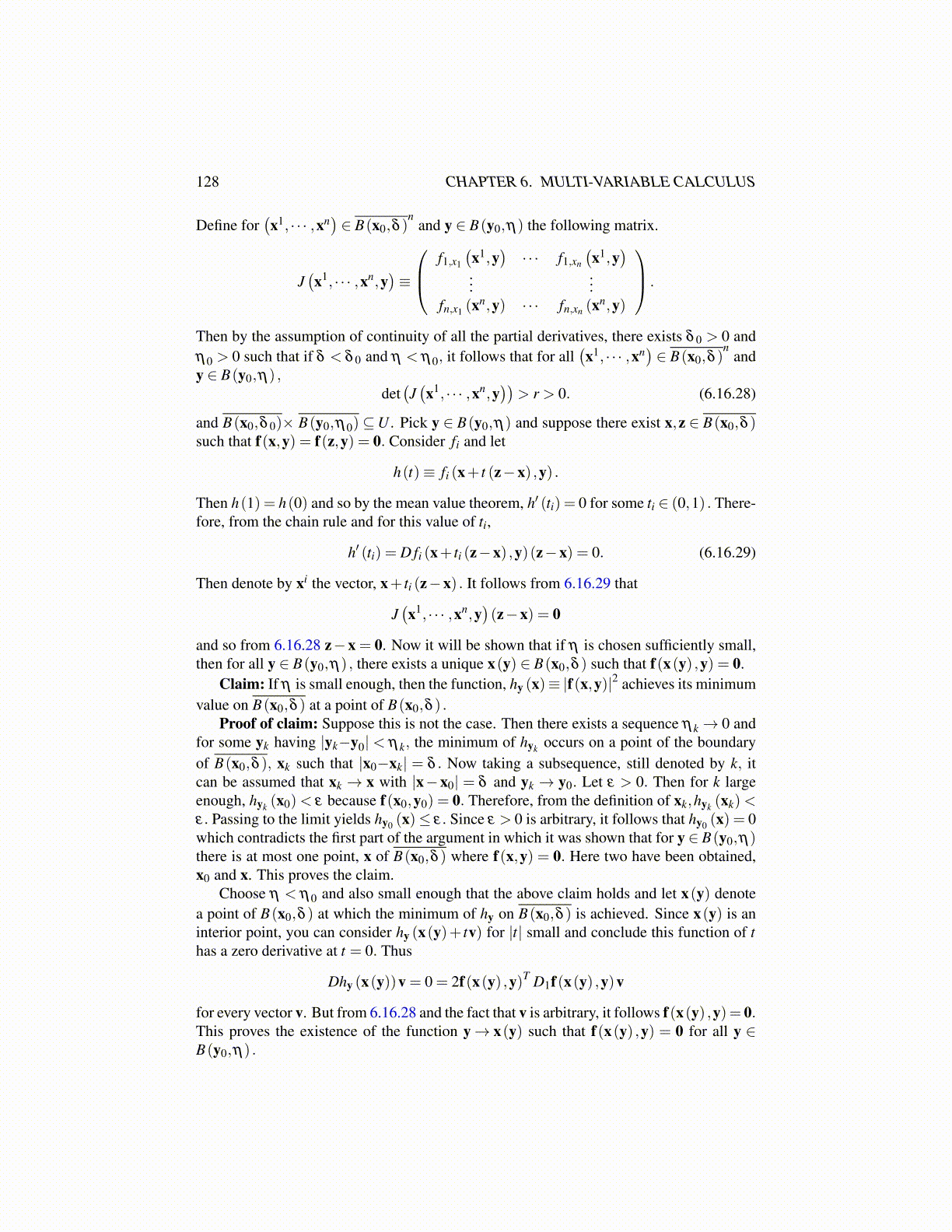
128 CHAPTER 6. MULTI-VARIABLE CALCULUS
Define for(x1, · · · ,xn
)∈ B(x0,δ )
nand y ∈ B(y0,η) the following matrix.
J(x1, · · · ,xn,y
)≡
f1,x1
(x1,y
)· · · f1,xn
(x1,y
)...
...fn,x1 (x
n,y) · · · fn,xn (xn,y)
.
Then by the assumption of continuity of all the partial derivatives, there exists δ 0 > 0 andη0 > 0 such that if δ < δ 0 and η < η0, it follows that for all
(x1, · · · ,xn
)∈ B(x0,δ )
nand
y ∈ B(y0,η) ,det(J(x1, · · · ,xn,y
))> r > 0. (6.16.28)
and B(x0,δ 0)× B(y0,η0) ⊆U . Pick y ∈ B(y0,η) and suppose there exist x,z ∈ B(x0,δ )such that f(x,y) = f(z,y) = 0. Consider fi and let
h(t)≡ fi (x+ t (z−x) ,y) .
Then h(1) = h(0) and so by the mean value theorem, h′ (ti) = 0 for some ti ∈ (0,1) . There-fore, from the chain rule and for this value of ti,
h′ (ti) = D fi (x+ ti (z−x) ,y)(z−x) = 0. (6.16.29)
Then denote by xi the vector, x+ ti (z−x) . It follows from 6.16.29 that
J(x1, · · · ,xn,y
)(z−x) = 0
and so from 6.16.28 z−x = 0. Now it will be shown that if η is chosen sufficiently small,then for all y ∈ B(y0,η) , there exists a unique x(y) ∈ B(x0,δ ) such that f(x(y) ,y) = 0.
Claim: If η is small enough, then the function, hy (x)≡ |f(x,y)|2 achieves its minimumvalue on B(x0,δ ) at a point of B(x0,δ ) .
Proof of claim: Suppose this is not the case. Then there exists a sequence ηk→ 0 andfor some yk having |yk−y0| < ηk, the minimum of hyk occurs on a point of the boundaryof B(x0,δ ), xk such that |x0−xk| = δ . Now taking a subsequence, still denoted by k, itcan be assumed that xk → x with |x−x0| = δ and yk → y0. Let ε > 0. Then for k largeenough, hyk (x0)< ε because f(x0,y0) = 0. Therefore, from the definition of xk,hyk (xk)<ε. Passing to the limit yields hy0 (x)≤ ε. Since ε > 0 is arbitrary, it follows that hy0 (x) = 0which contradicts the first part of the argument in which it was shown that for y ∈ B(y0,η)there is at most one point, x of B(x0,δ ) where f(x,y) = 0. Here two have been obtained,x0 and x. This proves the claim.
Choose η < η0 and also small enough that the above claim holds and let x(y) denotea point of B(x0,δ ) at which the minimum of hy on B(x0,δ ) is achieved. Since x(y) is aninterior point, you can consider hy (x(y)+ tv) for |t| small and conclude this function of thas a zero derivative at t = 0. Thus
Dhy (x(y))v = 0 = 2f(x(y) ,y)T D1f(x(y) ,y)v
for every vector v. But from 6.16.28 and the fact that v is arbitrary, it follows f(x(y) ,y)= 0.This proves the existence of the function y→ x(y) such that f(x(y) ,y) = 0 for all y ∈B(y0,η) .